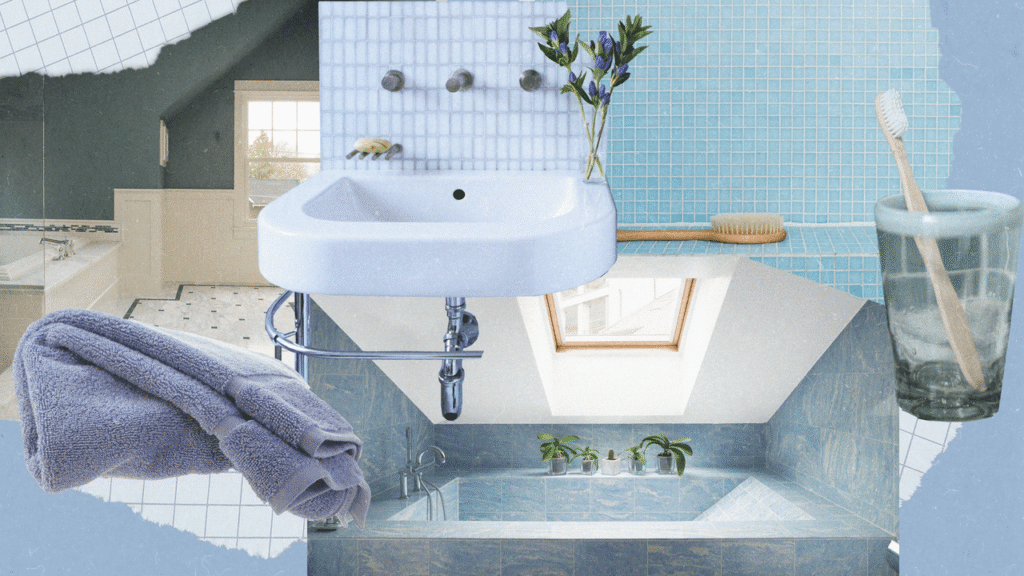What is the best blue bathroom color?
This one really depends on your own tastes. After all, you’re the person who’s going to be in the room the most. “Certainly depending on the saturation, lightness, and undertones of a blue, there are so many different moods and energies that a blue can evoke,” says AD PRO Directory designer Noz Nozawa. “It’s one of the more versatile colors I use to inform an energy or vibration in a space.” If you want to go for moody aesthetic, look for darker blues. To physically illuminate a space with little or no natural light, find something bright or powdery that artificial light can bounce off of. But don’t sleep on true blue. “A rich, saturated cobalt blue—especially in a high sheen—is a big statement that can carry even a space that doesn’t have many other elements in it. Or a pop of light baby blue in a room can lend a stately elegant note to a space,” says Nozawa. Ultimately, there is no one best shade. Think of it more as color theory depending on the mood you want to evoke.
What’s the best shade of blue to work with for bathrooms?
Speaking of color theory, this is where it really makes a difference. According to the London Image Institute, blue can convey trust, serenity, and peace—essentially, the opposite effects of red. Researchers have also found that blue can slow down a person’s pulse. “There is a reason why they call them the ‘moody blues,’ a blue hue sets a vibe and can go from soft and peaceful to dark and dramatic,” says Studio Gild principal Kristen Ekeland.
For the most relaxing blue bathroom, go for deep or denim hues. Lighter blues will lift spirits and come off a bit more playful. If you want to make a statement—and nod to the classic Bauhaus color palette—a pop or complete wash of cobalt will do the trick. “I love using the versatility of blues to match a specific color to the right context,” says Nozawa. “But my own personal favorite pops of blue are usually turquoise-leaning cerulean ceramics, rich and saturated.” Play with different types of blue by integrating objects in the colors you’re interested in—ceramics, sink accessories, towels, and art. Focus on different colors and how they make you feel when your eye catches them.
Ekeland’s favorite shade has a bit of a historical angle: “I’m obsessed with Prussian Blue,” she says. “[It’s] steeped in history, from its first emergence in 18th-century Germany to Pablo Picasso’s Girl in a Chemise, it’s a rich color that lends itself to every room in a house from a powder room to a moody den. It evokes water and the sea, which has always been my happy place.”
What are the best paint colors for a blue bathroom?
If you’re painting walls in your bathroom, keep in mind that darker colors are tougher to paint over when you’re ready for a change. This is one element that may help inform your decision, especially if you’re a renter. Nozawa swears by a number of paint colors that fall into the blue family: Benjamin Moore’s Blue, Benjamin Moore’s Blue Dragon, Benjamin Moore’s Van Courtland Blue, (“for a more dusty-historic hue”), and Farrow & Ball’s Hague Blue.
Ekeland has one tried-and-true go-to: “Since it was launched in 2018, Farrow & Ball’s De Nimes has been a blue paint color favorite,” she says. “I love that it can be feminine and masculine. It’s earthy with enough green to make it calming.”
What colors work best with blue?
Good news: You’re working with a real gem of a color. “Blue works so well with anything in the cool-temperature family,” says interior designer Tay Nakamoto. “From greens, teals, other shades of blues, then purples, and pinks (which is technically a cool and warm color).” It’s a very versatile shade; you don’t have to go wild with a bold combo if that’s not your vibe. If you’re feeling hesitant about pairing it with other colors, follow Nakamoto’s lead: “When in doubt, white works with any color at all.” This rings especially true if you’re into the coastal-bathroom look. Sometimes a crisp white stripe is all you need.
What are some considerations when choosing blue bathroom tile?
Blue tile can be a really fun way to inject a playful vibe into your bathroom design. If you’re going this route, you’ll want to make sure to weigh your options carefully. Tile is expensive, and you don’t want to end up with the wrong shape, color, or design. “Test your tile wet and dry,” Nakamoto cautions. “The shades of color can vary with that change, and if you prefer the vibrance of your tile when it’s wet, then you can choose a ‘wet-look sealer’ that protects your tile.” This layer won’t make it physically slippery, but it’ll still look as though it’s wet.
What is an unexpected place to add a pop of blue in the bathroom?
Sure, you could upgrade your shower curtain, you could go all-out on blue bathroom decor, or invest in a new set of towels. But if you’re looking to catch eyes, Nakamoto has a tip: “Grout! It’s very rare to take a gamble with a bold hue here. If you’re risky and want to stand out, go with the unexpected option of using colored grout.”


